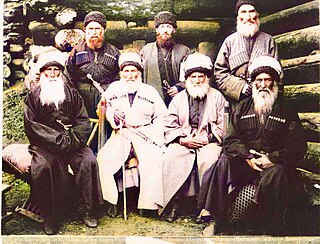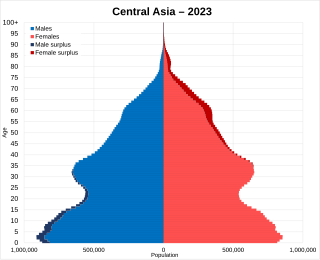Etymology
The term "almas" and numerous variants thereof appear in Mongolian, Turkic languages and Iranian languages. [3] [4]
Writing in 1964, scholar P. R. Rinčen says that "the origin of the old name is quite unknown … and it does not lend itself for translation in other languages". [lower-alpha 1]
The name is connected to a variety of place names (toponyms) in southwestern Mongolia, including Almasyn Dobo ('the Hills of Almases'), Almasyn Ulan Oula ('the Red Mountains of Almases') and ('the Red Rocks of Almases').
Folk belief in the almas in Ovorkhangai and Bayankhongor has resulted in a name-avoidance taboo there, wherein the entities may be referred to as akhai, meaning 'uncle-brother'.
The folk traditions of Darkhad include the Almas khara Tenguer, meaning 'Almas the Black God' and associated with highland prairies and mountain forests. According to Rinčen, the god may be offered edible wild roots and wild animal meat.

Kazakhstan, the largest country fully within the Eurasian Steppe, has been a historical crossroads and home to numerous different peoples, states and empires throughout history. Throughout history, peoples on the territory of modern Kazakhstan had nomadic lifestyle, which developed and influenced Kazakh culture.

The Yeti is an ape-like creature purported to inhabit the Himalayan mountain range in Asia. In Western popular culture, the creature is commonly referred to as the Abominable Snowman. Many dubious articles have been offered in an attempt to prove the existence of the Yeti, including anecdotal visual sightings, disputed video recordings, photographs, and plaster casts of large footprints. Some of these are speculated or known to be hoaxes.

The Kyrgyz people are a Turkic ethnic group native to Central Asia. They primarily reside in Kyrgyzstan, Uzbekistan, China, Pakistan and Afghanistan. A Kyrgyz diaspora is also found in Russia, Tajikistan, and Kazakhstan. They speak the Kyrgyz language, which is the official language of Kyrgyzstan.

The Ossetians, also known as Ossetes, Ossets, and Alans, are an Eastern Iranian ethnic group who are indigenous to Ossetia, a region situated across the northern and southern sides of the Caucasus Mountains. They natively speak Ossetic, an Eastern Iranian language of the Indo-European language family, with most also being fluent in Russian as a second language.

The Pumi people are an ethnic group. They form one of the 56 ethnic groups officially recognized by China.

The Karachays or Karachai are an indigenous North Caucasian-Turkic ethnic group native to the North Caucasus. They are primarily located in their ancestral lands in Karachay–Cherkess Republic, a republic of Russia in the North Caucasus. They have a common origin, culture, and language with the Balkars.

The yeren is a cryptid apeman reported to inhabit remote, mountainous regions of China, most famously in the Shennongjia Forestry District in the Hubei Province. Sightings of "hairy men" have remained constant since the Warring States Period circa 340 BCE through the Tang dynasty, before solidifying into the modern legend of the yeren. Generally, they are described as savage, strong, and fast-moving, living in mountain caves and descending only to raid villages in search of food or women.
Bryan Clifford Sykes was a British geneticist and science writer who was a Fellow of Wolfson College and Emeritus Professor of human genetics at the University of Oxford.

Tengrism is a religion originating in the Eurasian steppes, based on shamanism and animism. It generally involves the titular sky god Tengri, who is not considered a deity in the usual sense but a personification of the universe. According to some scholars, adherents of Tengrism view the purpose of life to be in harmony with the universe.

Shilajit, salajeet, mumijo or mumlayi or mumie is an organic-mineral product of predominantly biological origin, formed in the mountains.
The Neanderthal genome project is an effort of a group of scientists to sequence the Neanderthal genome, founded in July 2006.

Nicholas N. Poppe was an important Russian linguist. He is also known as Nikolaus Poppe, with his first name in its German form. He is often cited as N.N. Poppe in academic publications.

The nations which make up Central Asia are five of the former Soviet republics: Kazakhstan, Kyrgyzstan, Turkmenistan, Tajikistan and Uzbekistan, which have a total population of about 76 million. Afghanistan is not always considered part of the region, but when it is, Central Asia has a total population of about 122 million (2016); Mongolia and Xinjiang is also sometimes considered part of Central Asia due to its Central Asian cultural ties and traditions, although geographically it is East Asian. Most central Asians belong to religions which were introduced to the area within the last 1,500 years, such as Sunni Islam, Shia Islam, Ismaili Islam, Tengriism and Syriac Christianity. Buddhism, however, was introduced to Central Asia over 2,200 years ago, and Zoroastrianism, over 2,500 years ago.

The Denisovans or Denisova hominins(di-NEE-sə-və) are an extinct species or subspecies of archaic human that ranged across Asia during the Lower and Middle Paleolithic, and lived, based on current evidence, from 285 to 25 thousand years ago. Denisovans are known from few physical remains; consequently, most of what is known about them comes from DNA evidence. No formal species name has been established pending more complete fossil material.
Azerbaijani folklore is the folk tradition of Azerbaijani people.

The Scytho-Siberian world was an archaeological horizon that flourished across the entire Eurasian Steppe during the Iron Age, from approximately the 9th century BC to the 2nd century AD. It included the Scythian, Sauromatian and Sarmatian cultures of Eastern Europe, the Saka-Massagetae and Tasmola cultures of Central Asia, and the Aldy-Bel, Pazyryk and Tagar cultures of south Siberia.
al-Baranis, spelled sometimes as Barnès or Branes, are one of the two major groups to which Berbers (Amazigh) in the Maghreb and al-Andalus were divided by mediaeval genealogists and in some mediaeval Arabic sources, the other being called al-Butr.
The Family Among the Australian Aborigines: A Sociological Study is a 1913 anthropological book by the Polish scholar Bronisław Malinowski.
Valentin Ivanovich Rassadin was a Soviet and Russian linguist. He is best known for his documentation and studies of the Tofa language and Soyot-Tsaatan language.
 This article incorporates text from this source, which is in the public domain .
This article incorporates text from this source, which is in the public domain .











